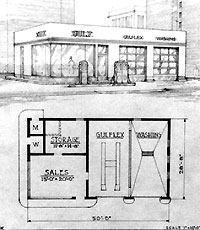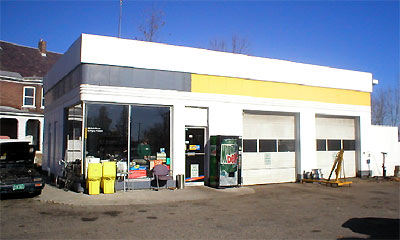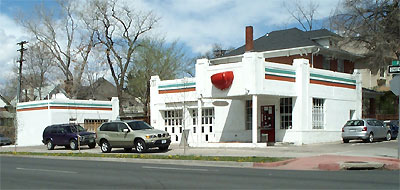Oblong Box Gas Station
The operational shift from “gas station” to “service station” marks an important corporate, consumer, and architectural milestone in the marketing of gasoline. In its first decade of operation, the gas station was a roadside facility dispensing gasoline, other petroleum products, and a limited line of automobile parts and accessories. As growing numbers of automobile owners sought the services of someone skilled in mechanical maintenance and repair, the gas station increasingly assumed the role. Early repairs and maintenance were often accomplished in an open area beside the station. A subterranean service pit or short ramp or lift gave the mechanic easier access to the underside of autos. Rain, snow, and intense sunshine often made these outdoor service areas unusable. Owners of early house-with-canopy or cottage-type gas stations sometimes built detached and later attached garages to accommodate year-round automobile service and repair. Thus was born the gasoline service station.
In the mid-1930s petroleum corporation executives, with their architects and industrial designers, began rethinking the function and organization of the service station. This was the period when modern architectural styles such as Art Deco and Moderne (sometimes referred to as Streamline Moderne) surged to popularity. The minimalist concepts of the International style also began to permeate the offices of American architects. These architectural movements corresponded with the rise of “industrial design,” improving the aesthetics and usability of products through such considerations as overall shape, location of details, colors, texture, sounds, and product ergonomics. This field also was concerned with the production process, choice of materials, and consumer point of sale presentation. All these design and architectural philosophies influenced the reshaping of the service station and yielded what is most often known as the oblong box-type station. Walter Teague produced a series of designs for Texaco that inspired similar designs throughout the industry. The above 1940 architectural plan and rendering of a Gulf service station epitomize the defining design characteristics of this building type.
All the functions of the station, except the actual pumping of gas, are accommodated in a simple rectangular plan building. The office/sales area occupies the prominent corner, facing the adjacent road intersection in street corner stations. Attached to the office are the service bays with roll-down glazed doors. Two-bay models predominate. Occasional single-bay versions may be found in small communities. Stations with three or more bays appear at busy roadside locations that emphasized auto service. Sometimes an original two-bay oblong box expanded to accommodate growing business by the construction of additional service bays.
Each bay of the two-bay station serves a specific purpose. One bay contains a hydraulic lift to raise cars for the servicing of tires, lubrication, and underside parts. A central in-floor drain to catch water runoff during car washes characterizes the second bay. A small storage area behind the office and adjacent to the first bay holds equipment and parts. Each station also contains a men’s and women’s restroom. The restrooms are usually accessed by exterior doors on the station’s side or rear elevations. In some stations, the women’s area opens from the station interior instead for the added protection of its users.
Oblong Box-Type Stations generally employ flat roofs, but occasional butterfly (V-shaped), shed, front gable, and neo-mansard examples may be found. Early Art Deco and Moderne styles sometimes included a rooftop pylon, prominently lighted at night, to attract the attention of passing motorists.
Art Deco/Moderne stations might include rounded corners, narrow cantilevered projections below the parapet, and porthole windows. International style stations featured almost no ornamentation other than narrow bands of color or slightly protruding belt courses wrapping the building above the door and window lintels.
Station designers of the period often took advantage of a new external material, porcelain enameled steel, for Oblong Box-Type Stations. Produced in panels, the material was bolted either to an underlying wood or metal frame or to a concrete block structure. The smooth shiny surface was low maintenance and generally durable. The reflective qualities of the surface allowed the buildings to glow at night for increased visibility. Oblong Box Stations were also made of painted concrete block or occasionally of brick.
Canopies extending over the pump islands were much more common on Art Deco/Moderne stations than the International style versions. Some stations, a prominent example being the Phillips 66 standard design of the 1960s, used inclined wedge-shaped or delta winged canopies each supported by a steel frame pylon rising above the roof to hold the prominent corporate sign.
Variations of the rectangular plan are common, most often with the office area projecting or being setback from the service bays. In some corner facing stations, service bays positioned along each side of the station intersect at the rear corner forming a square building plan.
Due to the nature of its heavy automobile traffic, landscaping generally consists of little more than a surrounding surface of concrete or asphalt paving. Lighting is most often accomplished by the use of tall pole lights at the property corners.
Oblong Box Stations continued to be built into the early 1970s, and they remain common along streets and highways, though most now serve non-automotive functions. As petroleum companies gradually surrendered automobile service to dealers and specialty service providers, the need for service bays diminished. The gas station-convenience store type currently dominates the industry. Retired Oblong Box Stations, minus gas pumps, now function as automobile service centers, florists, barber shops, travel agencies, coffee shops, and restaurants. The Quizno’s sandwich chain opened and continues to operate its first outlet in a former two-bay Oblong Box Station in Denver.
Common elements:
- rectangular plan
- flat roof
- lack of ornamentation
- corner office
- two service bays
- flat hard surface landscape



